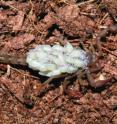New scorpion discovery near metropolitan Tucson, Arizona
A new species of scorpion, Vaejovis brysoni, was found in the Santa Catalina Mountains in southern Arizona. Another scorpion of the same group also inhabits this mountain range, making this the first documented case of two vorhiesi group species distributed on the same mountain. The study was published in the open access, peer-reviewed journal Zookeys. These mountains overlook the city of Tucson, Arizona. Amazingly, in the 21st century, there are still new species to be discovered right here in the United States. What is even more surprising is that the new species was found within sight of a large metropolitan area.
Recently Dr. Rob Bryson Jr. discovered this new species while looking for a completely different animal. Many important discoveries are made this way by scientists who start out working on something completely different. He sent specimens to the authors, who determined that they were indeed a new scorpion species. At that point, the team was assembled and the rest is history.
For over 50 years only four species of mountain scorpions were known from the state of Arizona. That number has more than doubled over the past six years, with a total of 10 species now known, all belonging to the same group. Arizona is known for isolated mountain habitats in the desert known as Sky Islands. These Sky Islands are where the new species are being discovered. "This latest new scorpion is a prime example of the amazing diversity of life still to be discovered, right here in 21st century America.," adds Richard F. Ayrey, one of the co-author of the original article.
Source: Pensoft Publishers
Other sources
- Arizona hills home to new scorpion speciesfrom MSNBC: ScienceWed, 20 Feb 2013, 22:30:16 UTC
- New scorpion discovery near metropolitan Tucson, Arizonafrom Science DailyWed, 20 Feb 2013, 3:00:38 UTC
- New scorpion species found near Tucsonfrom UPITue, 19 Feb 2013, 21:30:30 UTC
- New scorpion discovery near metropolitan Tucson, Arizonafrom PhysorgTue, 19 Feb 2013, 16:01:44 UTC
- Look out Tucson: New scorpion on the loosefrom Science BlogTue, 19 Feb 2013, 15:30:21 UTC


